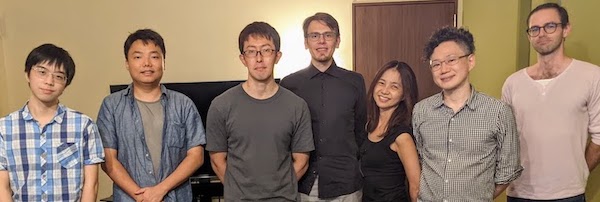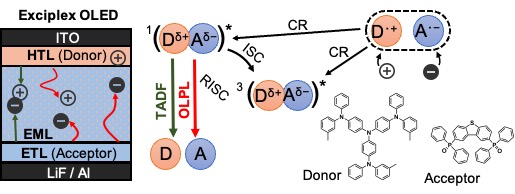FY2020 Annual Report
Organic Optoelectronics Unit
Assistant Professor Ryota Kabe

Abstract
FY2020 is practically the first year of our unit because LAB4 started in April 2020, and then we have begun to set up our laboratory. Due to COVID-19, there was a delay in installing equipment, but we were able to finish the set-up of the main equipment by the fall. New PDs (Zesen, Kiril, and Hayato) joined our unit. I also co-supervised two students as a visiting associate professor at Kyushu University, and both completed their Ph.D. and Master's degrees.
Regarding research, we have elucidated the thermal and electrical properties of stable organic excitons and charge-separated states. The possibility of charge accumulation in OLEDs was proposed from the similarity of the emission mechanism between OLEDs and OLPLs. We fabricated an OLED with having very thick emission layer was fabricated and demonstrated LPL from OLED. We also investigated thermoluminescence from the OLPL system to confirm the charge accumulation in the film.
1. Staff
- Kirill Mitrofanov, Staff Scientist
- Zesen Lin, Postdoctoral Researcher
- Hayato Ouchi, Postdoctoral Researcher
- Aleksandr Sorvanov, Rotation Student (2020/9-2020/12)
- Qizheng Zhang, Rotation Student (2020/9-2020/12)
- Rengo Yoshioka, Internship Student (2021/3-)
- Akiko Guzman, RUA ( - 2020/08)
- Emiko Aasato, RUA (2020/09 - )
2. Collaborations
2.1 Development of organic long persistent luminescence systems
- Type of collaboration: Joint research
- Researchers:
- Professor Chihaya Adachi, Kyushu University
- Kazuya Jinnai, Kyushu University
- Naohiro Nishimura, Kyushu University
- Shinichi Tan, Kyushu University
2.2 Analysis of organic long persistent luminescence systems
- Type of collaboration: Joint research
- Researchers:
- Professor Takashi Tachikawa, Kobe University
- Manabu Sakurai, Kobe University
3. Activities and Findings
3.1 Thermally activated processes in an organic long-persistent luminescent system
Glow-in-the-dark materials can store absorbed photon energy and emit light for long periods. While inorganic long-persistent luminescent (LPL) materials are crystalline and often require rare metals, organic LPL (OLPL) materials are flexible and require no rare metals. The emission process of OLPL systems consists of photo-induced charge separation, charge accumulation, and charge recombination. The charge separation and accumulation processes remain enigmatic.
In this study, we investigated the charge carrier dynamics of a binary OLPL system comprising of electron donors and acceptors. We confirmed the presence of a thermal activation process, resembling thermally activated delayed fluorescence and thermoluminescence in the OLPL system. We demonstrated the presence of thermal activation and TL in an m-MTDATA/PPT film. The TADF process represents not only the normal TADF process without charge separation, but also LPL from charge recombination. Therefore, triplet exciton management is important for highly efficient OLPL systems, similar to TADF OLEDs.

3.2 Long-persistent luminescence from an exciplex-based organic light-emitting diode
Although OLPLs and OLEDs include very similar excitonic processes, long-lasting emission has never been observed in OLEDs. In this study, we confirmed the presence of long-persistent luminescence (LPL) under electrical excitation. To obtain the observable LPL intensity after the current injection, a very thick emission layer and low donor concentration were required. In typical exciplex-based OLEDs, the LPL has not been reported so far because the charge recombination process is sufficiently fast owing to the good carrier balance and the thin emission layer. The OLPL obtained by electrical excitation was clearly observed by reducing the donor concentration and increasing the film thickness to enhance the charge accumulation process. Further analysis of the charge accumulation and charge recombination processes of the exciplex-based OLEDs is required to gain improved understanding of the OLPL systems.

4. Publications
4.1 Journals
[1] Tan, S.; Jinnai, K.; Kabe, R.*; Adachi, C.*
Long-persistent luminescence from an exciplex-based organic light-emitting diode
Adv. Mater. 2008844 (2021) DOI:10.1002/adma.202008844
[2] Jinnai, K., Nishimura, N., Adachi, C.*, Kabe, R.*
Thermally activated processes in an organic long-persistent luminescence system
Nanoscale 13, 8412–8417 (2021) DOI:10.1039/D0NR09227D
[Nanoscale Emerging Investigators 2021]
[3] Li, W., Li, Z., Si, C., Wong, M.Y., Jinnai, K., Gupta, A.K., Kabe, R., Adachi, C., Huang, W., Zysman‐Colman, E.*, Samuel, I.D.W.*:
Organic long‐persistent luminescence from a thermally activated delayed fluorescence Compound
Adv. Mater. 32, 2003911 (2020). DOI:10.1002/adma.202003911
4.2 Books and other one-time publications
[1] 嘉部量太, 光誘起電荷分離を利用した有機蓄光システム, 日本画像学会誌, 59, 316 (2020)
DOI: 10.11370/isj.59.316
[2] 嘉部量太, 有機材料を使った蓄光システムの開発, 応用物理, 90, 294 (2021)
DOI: 10.11470/oubutsu.90.5_294
4.3 Oral and Poster Presentations
[1] (Invited) R. Kabe, nanoGe Online Meetup Conference (2020-06-18, online)
[2] (Invited) R. Kabe, Riken CMES Topical Meeting (2021-01-28, online)
[3] Z. Lin, R. Kabe, C. Adachi, 2020 MRS Spring and Fall Meeting (2020/11/27-12/04, online)
5. Intellectual Property Rights and Other Specific Achievements
[1] R. Kabe, T. Tachikawa: 特願201475J, Organic Photostimulated Luminance
[2] K. Jinnai, R. Kabe, C. Adachi 特願211062J Long Persistent Luminescence Emitter
[3] K. Jinnai, R. Kabe, C. Adachi 特願211063J Long Persistent Luminescence Emitter
6. Meetings and Events
Nothing to report
7. Other
Nothing to report.



